The birth of a mission
Published in 20th-century / Contemporary History, Features, Issue 4 (Jul/Aug 2006), Volume 14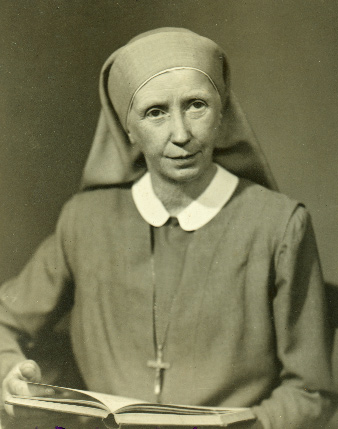
Mother Mary Martin, founder of the Medical Missionaries of Mary, in 1962. (Martin family)
Irish missionary orders had a dual mission—the religious and the medico-educational—and in many of the regions where they were active the legacy of schools and hospitals bear very obvious marks of their Irish inception. Irish missionary activity was gathering momentum in the early years of the twentieth century, and there were strong connections between the growing nationalism in civic life and the increasing fervour of religious commitment among both laity and Catholic clergy. It was against this background that no less than five Catholic missionary orders were founded: St Columban’s Society (also known as the Maynooth Mission to China) in 1916; the Missionary Sisters of St Columban in 1922; the Missionary Sisters of Our Lady of the Holy Rosary in 1924; St Patrick’s Foreign Missionary Society in 1932; and finally, in 1937, the Medical Missionaries of Mary. These orders were to have a very substantial influence on educational and medical provision in the countries where they put down roots, but their beginnings are often shrouded in myth or have simply gone unrecorded.
Mary Martin
The youngest of the Irish missionary orders was founded by Mary Martin. Despite some uncritical hagiography, her story as architect of one of the greatest Irish interventions in twentieth-century Africa has remained somewhat elusive. She was born Marie Martin in 1892 into a prosperous upper middle-class Dublin family, the eldest daughter in a family of twelve children. The Martins (trading as T. & C. Martin) were large timber merchants, and they had also built up their fortune in shipping. Sir Richard Martin, the brother of the firm’s first partners, had been high sheriff of Dublin in the 1860s and was the first Catholic to become a deputy governor of the Bank of Ireland; on his death it was noted how he had taken ‘a keen and constant interest in Catholic charities, and [that] every charitable and educational institution in Dublin owes much to his generous support’.
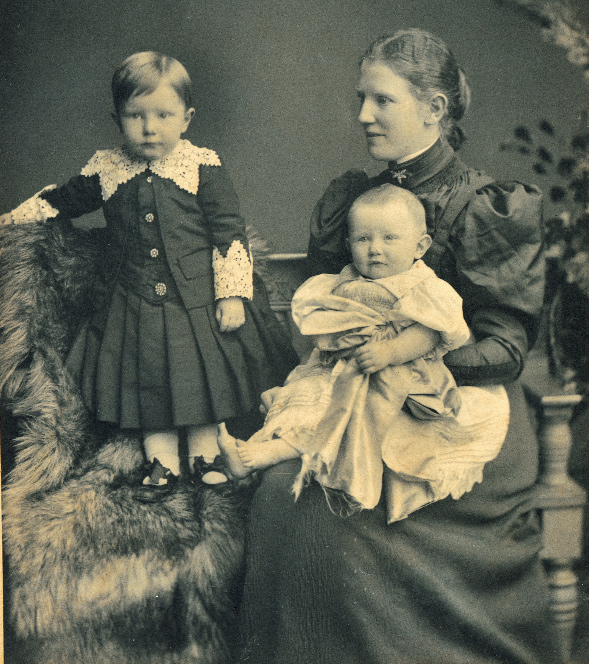
Baby Marie on her mother’s knee with brother Tommy-the epitome of a late Victorian, upper middle-class family. (Martin family)
Marie’s mother was a remarkable woman in her own right. She also came from the highest echelons of the Catholic business world in Dublin: the Moores owned coach- and carriage-making concerns and several corn mills; family tradition has it that they were superb horsemen and that a Moore was the first Catholic to be master of the Ward Union Staghounds. Mrs Martin was expecting her twelfth child when she was unexpectedly widowed in 1907. Further tragedies were soon to follow: two of her sons died on active service in the First World War and a third was drowned. When one, Charlie, was reported missing in 1915, she began to keep a daily journal in the form of a series of letters to him; she kept this up from December 1915 until the following May as a way, it seems, of coping with her loss. The journal gives a fascinating insight into the mental world of Anglocentric Catholics who were utterly comfortable with the Union. The Martins, of course, considered themselves Irish, but saw nothing paradoxical in sending their children to be educated in England or in their sons’ enlisting in the British Army.
Marie (or Mary as she came to be known on professing her vows) was brought up in Greenbank, a fine house on five acres in the south Dublin suburb of Monkstown. She was educated at home by a governess, before being sent to the Sacred Heart Convent in Leeson Street. While there she contracted rheumatic fever, and she attributed the delicate constitution that was to dog her all her life to that episode. After the death of her father, she was sent to a convent in Harrowgate, Yorkshire, and then in 1910 to a finishing school in Bonn. A year later, at the age of nineteen, she accompanied her Uncle Charlie on a cruise to the West Indies.
Voluntary Aid Detachment nurse in World War I
The sudden death of her father in 1907 clearly had the effect of strengthening the already close bond between Mary and her mother. War and the enlistment of three of her brothers reinforced that relationship. Mary herself joined the Voluntary Aid Detachment Nurses (VADs). She had practised first aid with the St John’s Ambulance Brigade at home, but this was to be her first experience of caring for the sick. After three months’ training she was posted to Malta, where she was thrown in at the deep end, caring for soldiers suffering from appalling injuries and disease.
It was while in Malta that the link between medical work and a spiritual vocation seems to have been forged in her mind. She was subsequently sent to a military hospital near Boulogne for a time. On her return from France during 1916 she met Fr Thomas Ronayne, her mother’s spiritual adviser. He had just volunteered for the new Maynooth Mission to China and, although not accepted, passed on his enthusiasm for the missions to Mary and her mother. He asked Mary whether she had considered religious life, and it seems that she expressed some interest in missionary work. Fr Ronayne put her in touch with Lady Frances Molony, the founder of the Columban Sisters, but she did not pursue the matter.
Some time later Mary Martin met a veteran missionary activist, Fr Joseph Shanahan, a Holy Ghost Father who had been working in coastal West Africa since 1902. This meeting had more profound consequences. Greatly impressed by the Protestant women missionaries who were beginning to run schools and medical clinics in southern Nigeria, Fr Shanahan championed the idea of a new congregation of women religious. He had been given permission to recruit priests for his mission in Nigeria and two of his volunteers were Fr Ronayne and Fr Patrick Whitney (later founder of St Patrick’s Society, Kiltegan), both of whom knew the Martins. Ronayne introduced Mary to Fr Shanahan around 1920, and she offered to go to Nigeria as a lay missionary on the completion of her midwifery course in Holles Street the following year. His response was the telegram: ‘Urgently needed, if you don’t mind facing things alone’.
Calabar
Mary Martin and another female volunteer, Agnes Ryan, set out in May 1921, leaving Dublin with a mixture of apprehension and excitement. Mary was very aware of the enormity of parting from her mother and her attenuated family but she was driven by a strong religious faith, as expressed in one of her almost daily letters to her mother:
‘It is dreadfully hard leaving you all but Our Lord is worth it and more. He will give me strength and comfort and I know I am going to be happy working for Him . . . We both had to make sacrifices when things were hardest but thank God for it, our reward will be all the greater.’
But she also spoke of other things in her letters home during the three-week voyage to Calabar:
‘Here are mostly young men on board, going out in the army or government jobs. Some of them for the first time, others very brown who have been there years and seem to like the life. Although it is hard they get home often. The pay is about £500 to begin with and everything found[;] it is not too bad but they say it is very lonely and the climate is very trying.’
In Calabar, Mary and Agnes were responsible for running the mission school. By October Agnes had succumbed to malaria and had to return home. Mary carried on for almost three years in Nigeria. It was a hard stint for someone who had no experience of teaching and had gone out with the impression that she would be gaining medical experience in the field. It was during this time that she was struck by the degradation of African women and the very high levels of perinatal mortality amidst the pervasive general poverty and disease.
Shanahan (now a bishop) saw as his next step the founding of an order of missionary sisters. There was one huge obstacle, however: Propaganda Fide in Rome forbade members of religious orders from practising obstetrics or giving aid in childbirth. Until such time as there was a papal change of mind, Shanahan saw education as the primary focus of his female order, and invited Mary to his council meetings to discuss plans. Mary told her mother in 1922 how
‘. . . two weeks were spent on rules and constitution. I was chosen as foundress, it may pave the way for someone more worthy. The order could not be founded before 1927, as five years are required to have novices trained and professed, to obtain approval from Rome and sufficient candidates and refer them to the bishop and myself, only those hoping to become sisters are to be sent out in future. This is very confidential.’
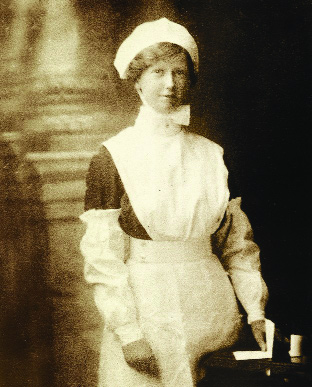
Marie Martin in 1915 (aged 23) in her VAD nurse’s uniform following her three months of training at the Richmond Hospital, Dublin. (MMM Image Archive)
Ordered home
In January 1924 Mary was ordered home by the bishop to enter a new novitiate in the missionary order of the Holy Rosary Sisters in Killeshandra under the supervision of two Dominican sisters. Despite serious qualms, she obeyed and returned home in March. Later in life she referred to this period as her hardest act of obedience. In March 1926 she chose to leave the convent, with the support of her mother:
‘. . . although the fact that you had decided to leave the convent would not help but be painful, I am sure that you were wise to make the break as you did and I know that you are only acting as you believe is in accordance with God’s will for you. I am with you heart and soul.’
Bishop Shanahan was deeply disappointed with her decision but acknowledged her pivotal contribution to his foundation of the Holy Rosary Sisters in a remarkably honest way:
‘I will always pray for you and never forget that it was you who inspired and you who were the chief instrument in the formation of the new Mission Society . . . Were it not for you, I would never have taken the steps I took to get it started.’
This was not the end of Mary’s African involvements. For four years she suffered continual ill health, but this did not deter her from her goal of establishing a missionary organisation that would be allowed to assist women in childbirth and, more broadly, to attend to the medical needs of the people. She received constant support from her religious friends in Calabar.
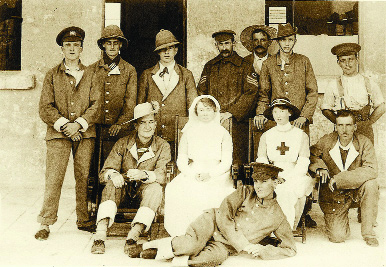
Marie Martin (with red cross on her uniform) in Malta, January 1916. It was while in Malta that the link between medical work and a spiritual vocation seems to have been forged in her mind. (MMM Image Archive)
The Benedictine connection
In 1933, with the recovery of her health and the green light from her family doctor, Mary set about drawing up an outline of the missionary order she sought. Fr Hugh Kelly advised her that ‘your main difficulty will be to strike the balance between the doctor and the religious, between professional efficiency and an interior life, between work and prayer’. In September that year came yet another turning-point: a chance meeting (through her aunt) with Dom Gerard, the prior of the recently established Belgian Benedictine community in Ireland, who had just opened a boarding school for boys in Glenstal, Co. Limerick.
Dom Gerard was in dire straits concerning the domestic arrangements (or rather the lack of them) in his fledgling school; Mary was struggling to design the necessary structures for the spiritual formation of her hypothetical religious order. She suggested that in exchange for spiritual instruction for herself and her future followers she would look after the school’s domestic arrangements. She was no stranger to the Benedictine way of life as all her brothers had been educated at Downside, and she was drawn to the broad view inherent in the Benedictine ethos.
Thus on 21 March 1934 Mary Martin and her first candidate, Nora Leydon, arrived in Glenstal. The novice master, Dom David Maffei, was appointed as their spiritual instructor. When Dom Gerard returned to Belgium in September, he was replaced as prior by Fr Bede Lebbe OSB. It was the start of a great friendship. Mary and he had much in common, both struggling to establish new foundations, and in this situation they drew support and encouragement from each other. This link with the Belgian Benedictine community was invaluable as it provided Mary not only with the necessary spiritual discipline out of which she could form a constitution for her order but also gave her vital advice on how to handle the Catholic hierarchy at home and Vatican officialdom in Rome. The Benedictines gave her strong support, investing her foundation with status at a time when the Irish Catholic hierarchy were less than enthusiastic.
The Benedictines helped Mary to draft a petition to Propaganda Fide with an outline of her plans for an order specifically dedicated to maternity. This period in Glenstal gave her time to develop her vision for the future foundation and gave her a base to receive other candidates interested in joining her. At the same time she brought order and calm into the somewhat chaotic domestic arrangements at Glenstal. She organised and interviewed domestic staff, and then trained them to a high standard. She guided the monks in the practicalities of running the school, helped them to attract and secure applications, and even advised on the school uniform.
Clearance from Rome
In February 1936 Propaganda Fide finally lifted the ban on women religious working in maternity and obstetrics, and immediately encouraged women to undertake work in this field. This was a huge boost to Mary Martin and her growing band of followers. She immediately sent a petition to Rome seeking permission to set up a missionary order devoted to the care of the sick, with special emphasis on mother and child. Fr Bede Lebbe OSB also sent a letter explaining how she and her followers had received spiritual formation in his priory.
Within three months Mary received clearance from Rome to set up such a foundation. The following September she and her group of aspirants moved to Rosemount, a house in Booterstown, Co. Dublin, which had been purchased by her brother for the use of the new order. (It is still in the hands of the Medical Missionaries of Mary.) The previous spring, while word from Rome was awaited, two of her candidates had gone to Holles Street to train as nurses. Shortly after the move to Rosemount, Archbishop Riberi, apostolic delegate to East and West Africa, authorised Mary Martin to set up her foundation in Africa. By February 1937 Mary and her two candidates had reached Nigeria, where they decided to undertake their novitiate under the auspices of the Holy Child Nuns, who had a school and small hospital out in the bush at Anua:
‘The newcomers had a mud-block house to which the last touch, a coat of whitewash, was being put as they arrived. Beds and other essentials were unpacked and installed, the packing cases serving as temporary stools and cupboards.’
Almost immediately Mary fell ill with malaria and had to be brought on a 70-mile journey by kit-car to the ‘European’ hospital in Port Harcourt. On arrival she was so ill that there seemed little chance of survival. But a week later Mgr Moynagh, the diocesan authority for Calabar, received permission from Rome to set up the congregration of the Medical Missionaries of Mary and to receive the vows of its founder. On 4 April 1937, Mary Martin was professed in the hospital in Port Harcourt.
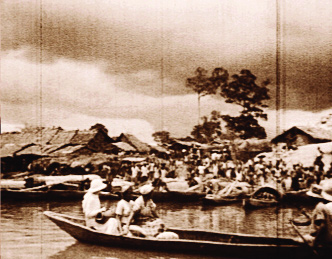
Still from the 1947 film Visitation, commissioned by Mother Mary Martin, which re-enacted her journey by canoe up the River Niger in December 1921 to meet Bishop Shanahan. (MMM Image Archive)
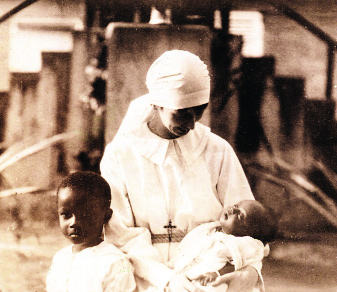
With Nigerian children during her work as a lay missionary, 1921–4. (MMM Image Archive)
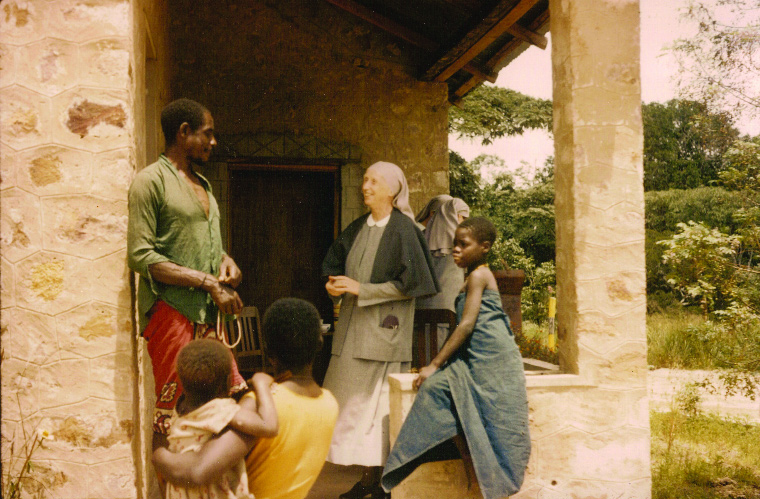
Mother Mary Martin on her visitation to missions in Tanzania (then Tanganyika), December 1959–January 1960. By the time of her death in 1975 the Medical Missionaries of Mary had some 450 members working in Ireland, England, Angola, Ethiopia, Kenya, Malawi, Nigeria, Tanzania, Uganda, Brazil and the USA. (MMM Image Archive)
She was instructed by Rome to return to Ireland and make a foundation there. Still enfeebled, she departed from Anua, leaving her two novices to continue their novitiate. There was little hope amongst those who saw her off that she would survive the journey home, let alone that her newly founded congregation would play such a huge role in the medical and educational history of southern Nigeria in the decades ahead. By the time of her death in 1975 the Medical Missionaries of Mary had some 450 members working in Ireland, England, Angola, Ethiopia, Kenya, Malawi, Nigeria, Tanzania, Uganda, Brazil and the USA.
Mary Dempsey is completing a master’s dissertation on Mary Martin in the Department of History, Trinity College, Dublin.
Further reading:
E.M. Hogan, The Irish missionary movement (Dublin, 1990).
M. Purcell, To Africa with love (Dublin, 1987).
















